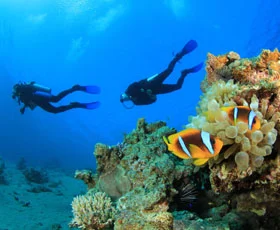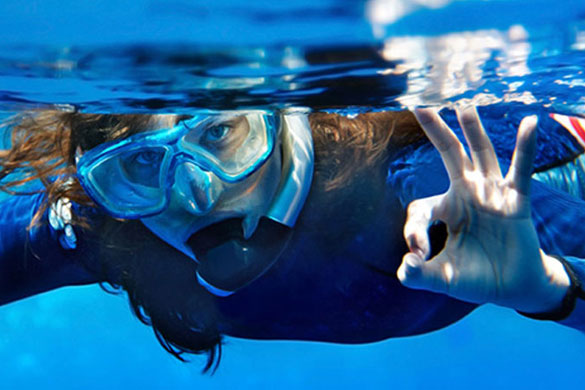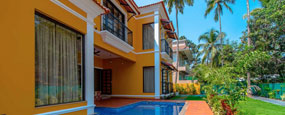Selecting a Mask and Snorkel When selecting a mask, fit and comfort
are important. You don't want a mask that leaks constantly because
it doesn't fit your face. So you need to go somewhere where you can
try on the masks. This would most likely be a scuba shop. Look in
the Yellow Pages under Divers Equipment and Supplies. You can also
watch for the symbol at right which is a dive flag, usually prominently
displayed on the front of scuba shops.
To try on the mask, move the strap out of the way, brush your hair
out of the way, and just push the mask firmly onto your face. If it
will remain there unsupported, then it is making a good seal. Once
you have determined which masks will fit properly, other considerations
are comfort, field of vision some masks permit more view to the sides
than others, and of course the cost. Get a snorkel also and maybe
a spare strap to hold it to your mask. The snorkel mouthpiece should
be soft with flexible edges to be comfortable in your mouth.
-
Fins
Fins aren't really a necessity for snorkeling, but they do help
you to get down more quickly so that you can see more of the underwater
world on that breath of air. For me, the major concern here is comfort
when selecting fins. Nothing will raise a blister faster than ill-fitting
fins. Scuba divers wear neoprene foam "booties" with their fins
and this helps immensely. But because of the thickness of the booties,
this may require a different foot size of fins. Another variable
is the fin area. A larger fin area may allow you to swim somewhat
faster but requires more "horsepower" to operate. A larger fin size
will also be heavier, may make you clumsier in the water, impossible
to walk in on land, and may be damaging to the underwater environment.
My personal favorite is Force(tm) fins. These have a relatively
small fin area, are made of a very supple flexible material, and
are an open-toe design. The closed-toe design of most fins is a
source of discomfort since the strap which holds the fin on puts
pressure on the toes inside the fin. It is even possible to walk
while wearing the Force(tm) fins although this is generally a bad
idea. Your friends will notice the resemblance to duck feet that
these fins suggest but it's a small price to pay for total comfort.
They can be worn without booties, but you will need to decide whether
or not to use booties since this will affect the foot size of the
fin that you select.
-
Using the Snorkel
To keep the snorkel upright while you are swimming face down on
the surface, the snorkel strap will need to be adjusted properly
on the mask strap. Since the snorkeler cannot see the snorkel while
it's in use, it may be helpful to have someone watch you and help
you find the proper adjustment. For me, it's with the strap well
forward, almost against the mask. Now you can swim along the surface,
breathing through the snorkel and observing the world below. When
you see something interesting you can hold your breath and dive
down to have a closer look. In order to stretch your time below,
it is important to be relaxed and not expending a lot of energy.
It also helps to be able to get down quickly. To start down, rotate
your body so that you can put your head straight down and stick
your legs straight up and out of the water. Then let gravity do
its thing and you should be on your way down without moving a muscle.
When your downward speed has deteriorated you can begin kicking
to continue. For the return to the surface, tilt your head back
and watch where you are going. You wouldn't want to bang your head
on the bottom of a boat. You should reserve enough air in your lungs
so that after you break the surface--with your head still back so
that the open end of the snorkel will be pointing down--you can
send a quick burst of air through snorkel to help expel any remaining
water. And you are ready to continue swimming on the surface, face
down, breathing through the snorkel. Scuba divers are taught to
ascend with one hand stretched upward to prevent striking an object
with one's head and also to be more visible to boat traffic when
surfacing. It's not a bad idea for snorkelers to do the same.
-
Clearing your Ears
If you descend more than a few feet from the surface you may begin
to feel some pressure on your ears. If so, you will need to equalize
the pressure before proceeding further. For some, this may happen
naturally; others may need to make a conscientious effort; and for
some it may be impossible to clear the ears due to cold or other
sinus problems. Pressure on the ears is equalized by holding one's
nose and blowing gently. You should hear a crackling sound and feel
the pressure subside. Try it now. It is actually better to do this
before pressure is felt since the unequalized pressure tends to
collapse the passages that are used to equalize. Scuba divers may
even do this exercise before arriving at the dive site to insure
that passages are clear and they are ready to equalize. If you have
a problem, return to the surface, attempt to equalize again, and
then start down. Under no circumstances should you do anything that
is painful for your ears.
-
Snorkeling Hazards
The Pacific Coast of Oaxaca does not have large coral reefs, but
there is a lot of coral there. Coral is made by tiny creatures who
go out and collect discarded razor blades and cement them together
to build sturdy, defensible homes. Okay, I'm kidding; some coral
is actually quite fragile and can be easily damaged by clumsy swimmers,
but it is often razor sharp, which is another reason to avoid contact.
Many a diver has returned to the surface with bloodstained legs
without realizing he or she has been injured. Another common hazard
is the sea urchin. These are small, black spherical creatures with
thin black spines 2-3" in length radiating in all directions. They
congregate on the rocks and in crevices and feed on algae. The spines
are quite sharp and the tip may break off and remain embedded in
the skin if these are contacted. They evidently contain mild venom
because the pain and swelling of these wounds is out of proportion
to the small injury. There are a number of varieties of moray eels
in the area. These are generally small--an inch or so in diameter
and a couple of feet or so in length. They inhabit crevices in the
rocks and often extend their head and a portion of their body out
into the water. They are quite beautiful and interesting to watch.
If you get close enough, you can see the intricate patterns on their
skin. But don't offer your finger. They've got teeth! There are
a few varieties of shark in the area. The fishermen sometimes bring
in large quantities, but they have to go to deep water and put out
bait to find them. Most of them are too small to be a threat to
swimmers. I am not aware of any injuries caused by sharks on the
coast of Oaxaca nor have I seen one in the water. There are periods
when the ocean becomes too rough for snorkeling. This phenomenon
is known as Rebalses. Other times it’s known as Hurricane.
Hurricane season is July - October. See the weather links at the
top of the page. Selecting a Site What makes a good snorkeling site
depends on so many factors and varies with weather conditions, so
that it is best to get some advice from locals who snorkel. Dive
shops are a good source of information and probably offer snorkeling
expeditions as well. A lot of sites are most easily accessed by
boat. Fishermen may be of help as well. They usually finish fishing
around 9 or 10 am and would probably love to take you snorkeling
for a small charge. A good site will probably be in a protected
bay where there is calm water and not much current. A municipal
bay may not be a good place due to pollution that contaminates the
water and discourages sea life. A bay into which a river empties
may not be a good site due to low visibility because of silt from
the river, especially after heavy rainfall. Areas around rocky outcroppings
are often good because they attract fish, may block the current,
and boaters avoid them. However, if there is a lot of surge (oscillating
currents) they can be too dangerous. Snorkeling at Night Snorkeling
at night can be very rewarding.
There are a number of creatures that just don't come out in the
daytime. It is important to select a snorkeling site that you are
already familiar with. You will need an underwater flashlight. Get
one from a scuba shop before you leave on your trip because it may
be difficult or expensive to find one in Mexico. The kind that uses
8 D-cells makes a nice bright light, but the type that uses 2 D-
or C-cells will be adequate and easier to carry. It is also a good
idea to carry a chemical light to make you more visible to boaters.
These are also available at scuba shops and again it would be best
to purchase before your trip. The chemical light is a one-time use
light that glows for several hours after activation. Activate it
before you get in the water and tie it to your wrist. They are just
cool too.







